Wouldn’t it be brilliant if there was a tool to help you work out which wines represent the best value for money? Well look no further; our Value Pick indicator algorithm puts that knowledge at your fingertips.
Analysing the very latest price data and reviews from our partner critics, Wine Lister’s algorithm awards Value Pick status to those wines that achieve the best quality to price ratio (with a proprietary weighting giving more importance to quality, thus allowing the finest wines a look-in). Crucially, Value Picks are awarded at vintage not wine level.
Here are Wine Lister’s newest Value Picks:
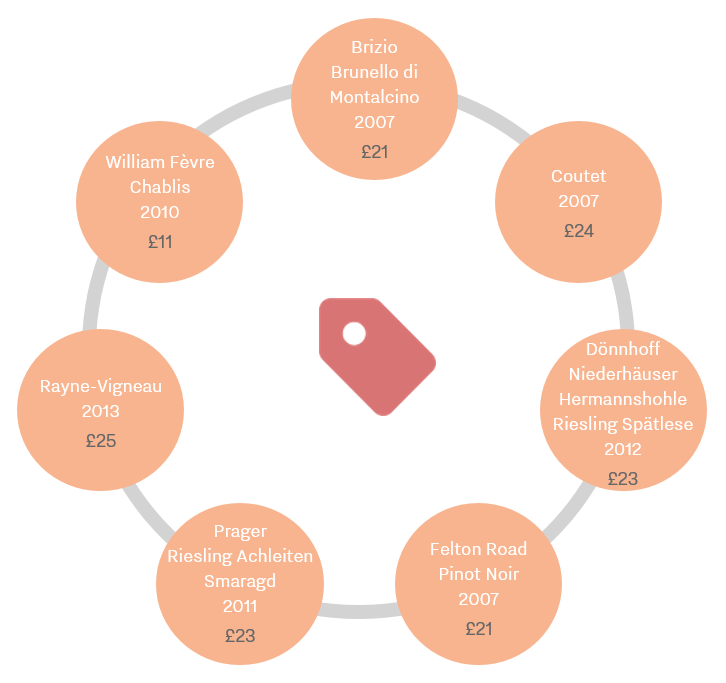
Wine Lister’s prices per bottle are provided by our price partner, Wine Owners, whose own proprietary algorithms process millions of rows of incoming price data from Wine-Searcher to calculate a more realistic Market Level price – the price at which a wine is likely to find a ready buyer – based on market supply and spread models. Wine Owners believe lower retail prices will sell first, hence their price may be below the Wine-Searcher average in some instances. As you can see, using this method, each of the new Value Picks is priced at £25 or under, with the cheapest costing just £11 (excluding tax).
Furthermore, other than William Fèvre Chablis (64/100), all of these wines have an average critic score of 74-77/100 on Wine Lister’s rebased, calibrated scale (where any score above the average of 40-60/100 is strong). Underlining their appellations’ reputation for excellent value, two sweet white Bordeaux feature in the list: Coutet Premier Cru 2007, from Barsac, and Rayne-Vigneau Premier Cru 2013, from Sauternes. Each earning an average critic score of 77 and with plenty of life still in them, these represent remarkable value for money.
Yesterday saw the release of Pol Roger 2008. Heralded as “admirably long” and “really exciting” by Wine Lister’s partner critic Jancis Robinson, here we look at all the key data:
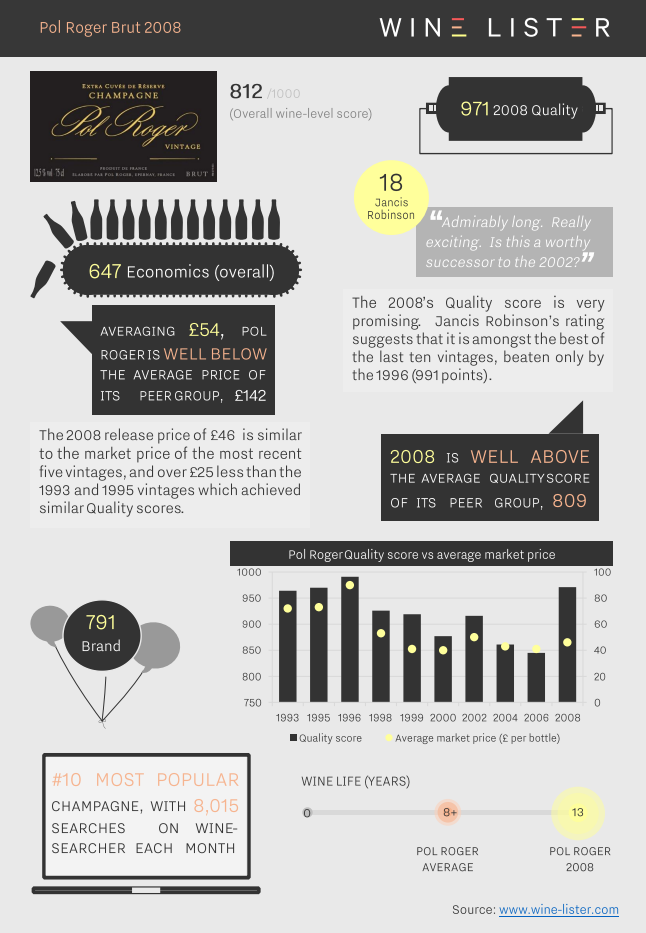
You can download the slide here: wine-lister-factsheet-pol-roger-2008
Yesterday saw the release of the latest vintage of Sassicaia, the challenging 2014 vintage. None of our partner critics has yet tasted scored the wine in bottle, but Vinous’s Antonio Galloni found the wine “promising” from barrel (read more here).
Wine Lister’s CEO, Ella Lister, recently attended a 44-vintage tasting of Sassicaia in Rome, beginning with its first commercial release, 1968. “This once-in-a-lifetime tasting proved the amazing consistency of the wines’ quality as well as their extraordinary ageing capacity”, she reported.
In the context of this release, we explore the whole gamut of vital facts about Sassicaia, a formidable wine regardless of the vintage:
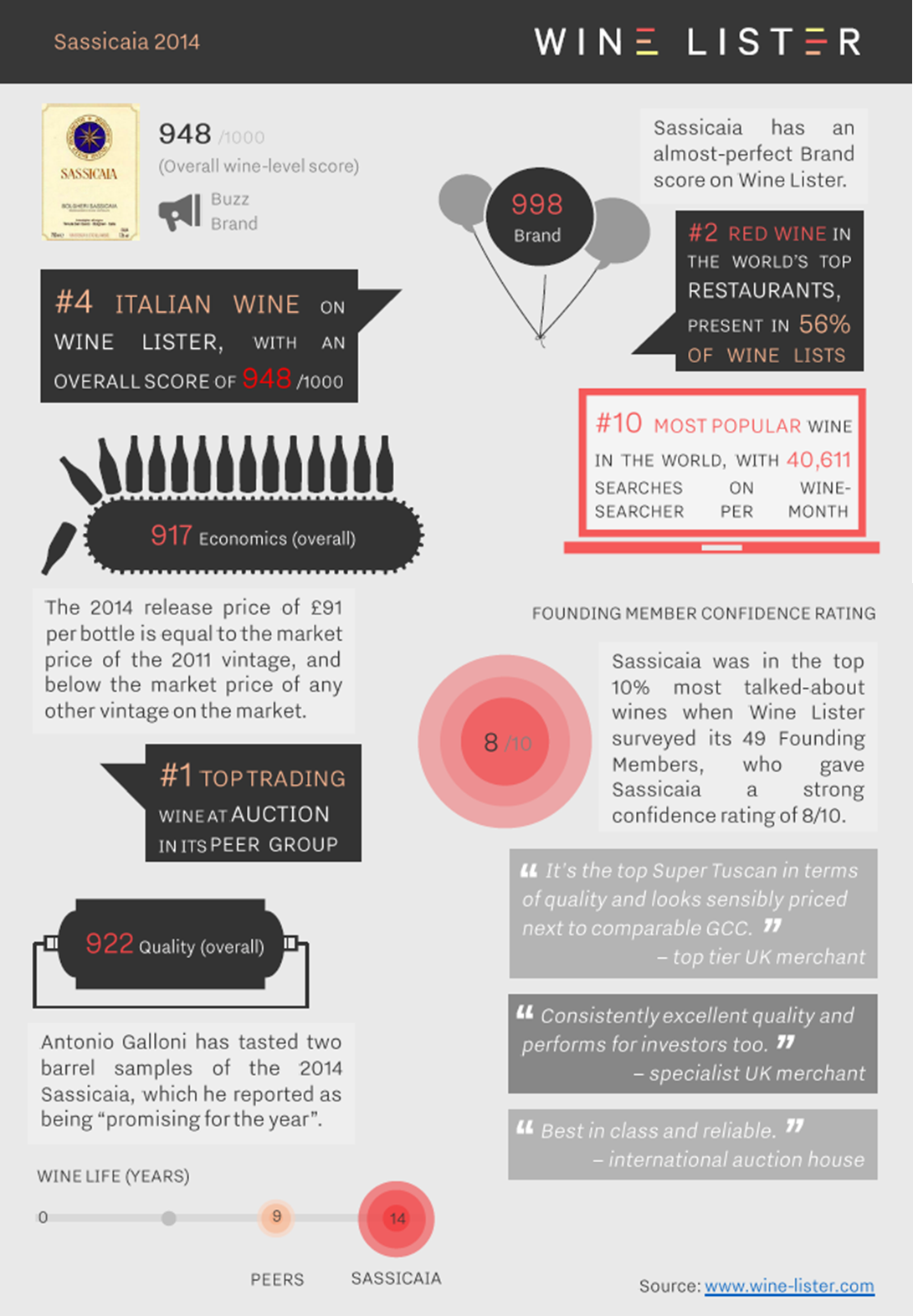
You can download the slide here: wine-lister-factsheet-sassicaia-2014
As we know, the quality of a wine is not set in stone. Just like our Brand and Economics scores, Wine Lister’s Quality scores are also updated over time as wines evolve and new vintages are released.
Our algorithm analyses Quality by aggregating ratings from our three partner critics: Jancis Robinson, Bettane+Desseauve and Vinous (Antonio Galloni). It also comprises a small weighting for a wine’s longevity, based on the critics’ combined drinking windows, with the drink-by date updated regularly as our partner critics retaste and reevaluate.
In this post we look at the 10 biggest gainers in Quality over the course of 2016:
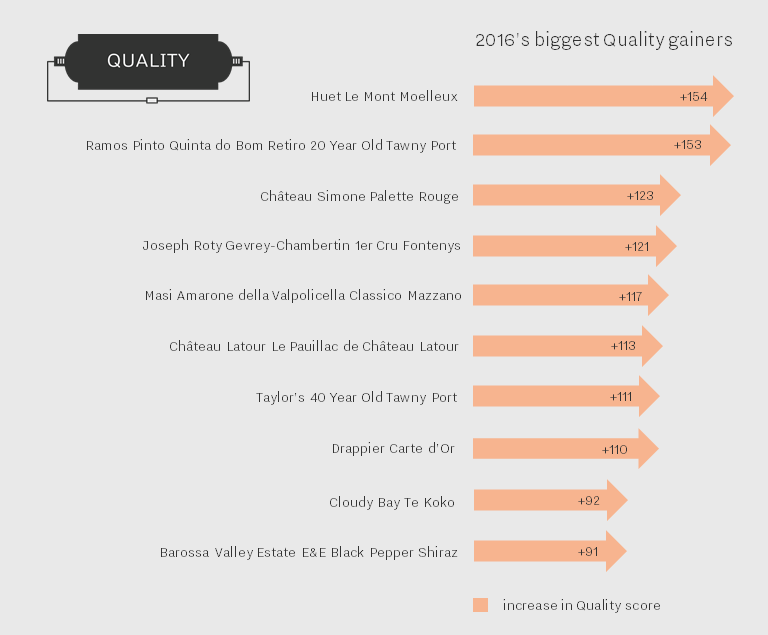
Huet’s Le Mont Moelleux improved the most last year, adding over 20% to its score, taking it to 917. This is down to a score of 18/20 for the 2015 vintage from our UK partner critic JancisRobinson.com.
Also partly thanks to a new score of 18 from the same critic, in second place is the fortified Ramos Pinto Quinta do Bom Retiro 20 Year Old Tawny Port. The wine was also deemed to be eight years longer-lived than had been previously thought, contributing considerably to its Quality score surge.
Château Simone’s Palette Rouge received a higher-than-average score from Bettane+Desseauve for its 2012 vintage, making it the third-highest gainer for the year.
Improvements were also enjoyed across a wide range of other regions, from Bordeaux to Champagne, and in the New World.
Who will be 2017’s biggest Quality gainers? Only time (and tastings) will tell.
Here’s the latest instalment of our monthly series on biggest Brand gainers.
The latest Wine-Searcher search frequency data is in, allowing us to update our Brand scores with changes to each wine’s popularity (one of the two criteria contributing to the Wine Lister Brand score, the other being a wine’s presence in the world’s top restaurants).
The chart below gives us a breakdown of the five wines which improved their Wine Lister Brand score most during December:
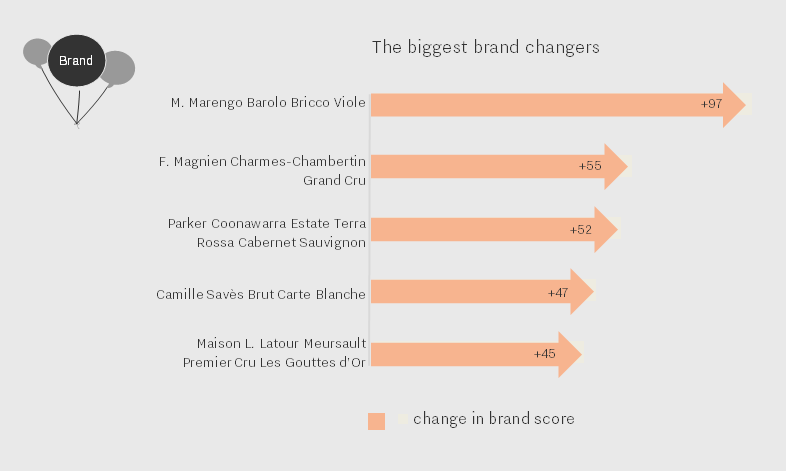
The top five Brand gainers are not concentrated in any one country or region, with Italy, Australia, and three different French regions all represented.
As in November, Barolo is again represented. With a percentage increase of 28% in Brand score, Marengo’s Barolo Bricco Viole saw a surge in monthly online searches, increasing from an average of 103 to 342.
The second biggest gainer is Magnien’s Charmes-Chambertin Grand Cru, whose average monthly searches have doubled, helping raise its overall Brand score above the Wine Lister average to 545/1000.
We’ll be back next month with an update on January’s biggest Brand changers.
We’re always adding new features to Wine Lister, and in direct response to your feedback, we are pleased to introduce our new wine comparison tool. Released late in 2016 (it wasn’t all bad!), this is a valuable, visual device for comparing up to three wines of your choice.
Whether you want to look at three vintages of the same iconic wine, three cuvées from the same producer or three completely different wines, our comparison tool allows for an instant side-by-side analysis of each of the 11 criteria (across three main categories) that make up Wine Lister’s overall score.
Let’s look at it in practice. Below you will see Domaine du Comte Liger-Belair’s Vosne-Romanée Premier Cru Les Suchots:
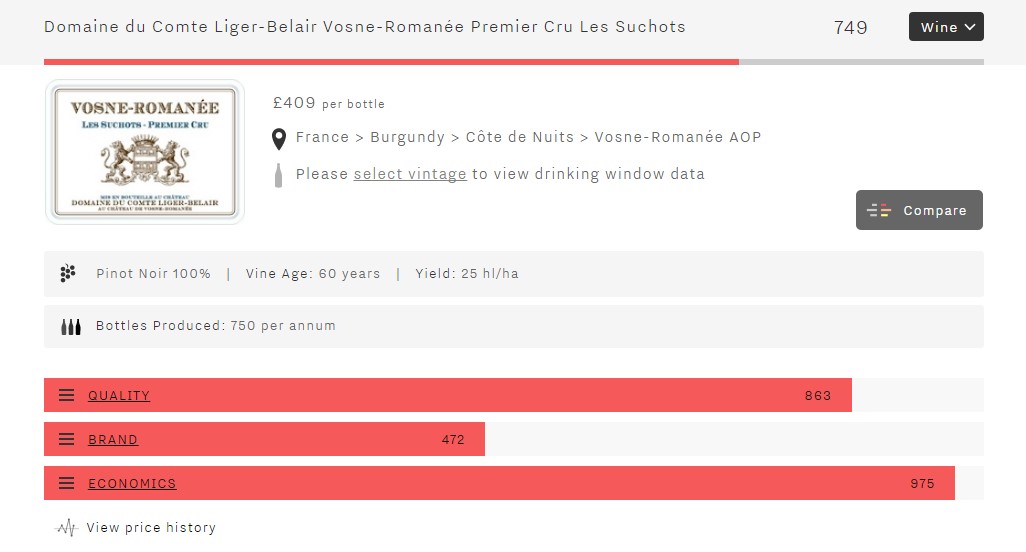
By simply clicking “Compare“, you can add up to two more wines to the analysis:
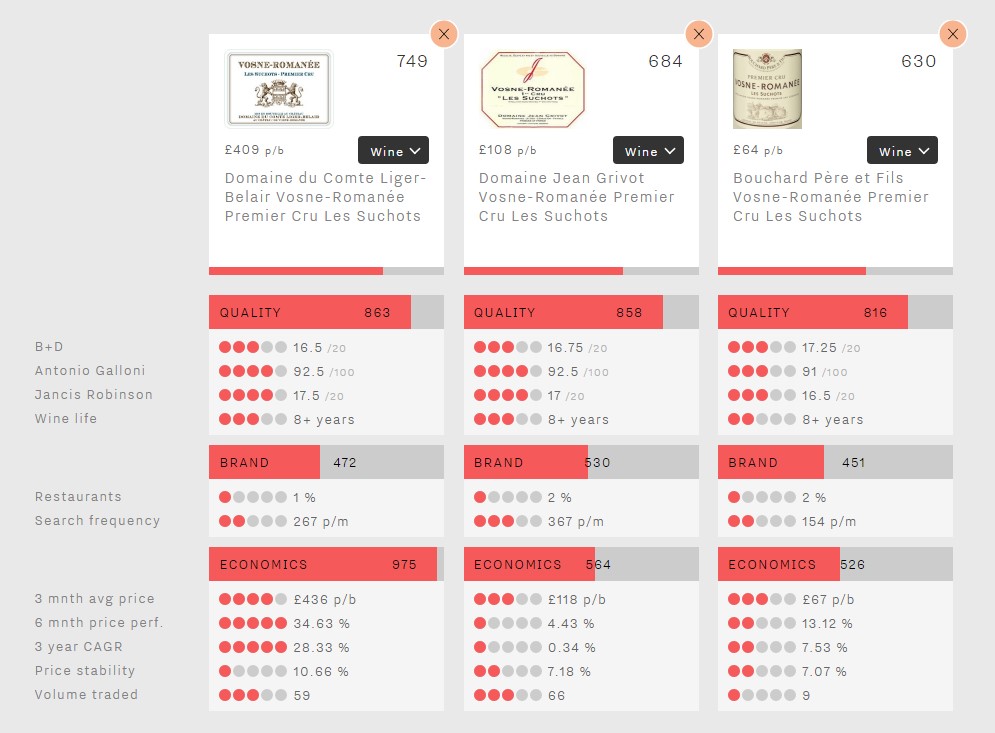
In this instance, we have chosen to analyse three different producers’ wines from the lieu-dit of Les Suchots in Vosne-Romanée, at wine-level rather than in a specific vintage. We can quickly see that these three Les Suchots wines score similarly well in Quality, but in Brand and Economics there are greater differences. Grivot’s Les Suchots scores highest in Brand, while that from Bouchard scores lowest. It is the outstanding Economics score from Comte Liger-Belair’s example that brings it out on top in the overall Wine Lister score.
In-depth wine comparison has never been quicker or easier! Try it for yourself (subscription or free trial required).
We’ve updated Wine Lister scores to incorporate the latest search frequency data from Wine-Searcher. The higher the relative search frequency of a wine, the higher the popularity score and consequently the better the wine’s Brand score.
The chart below shows the impact of the new online search data on Brand scores, showing the top five biggest gainers.
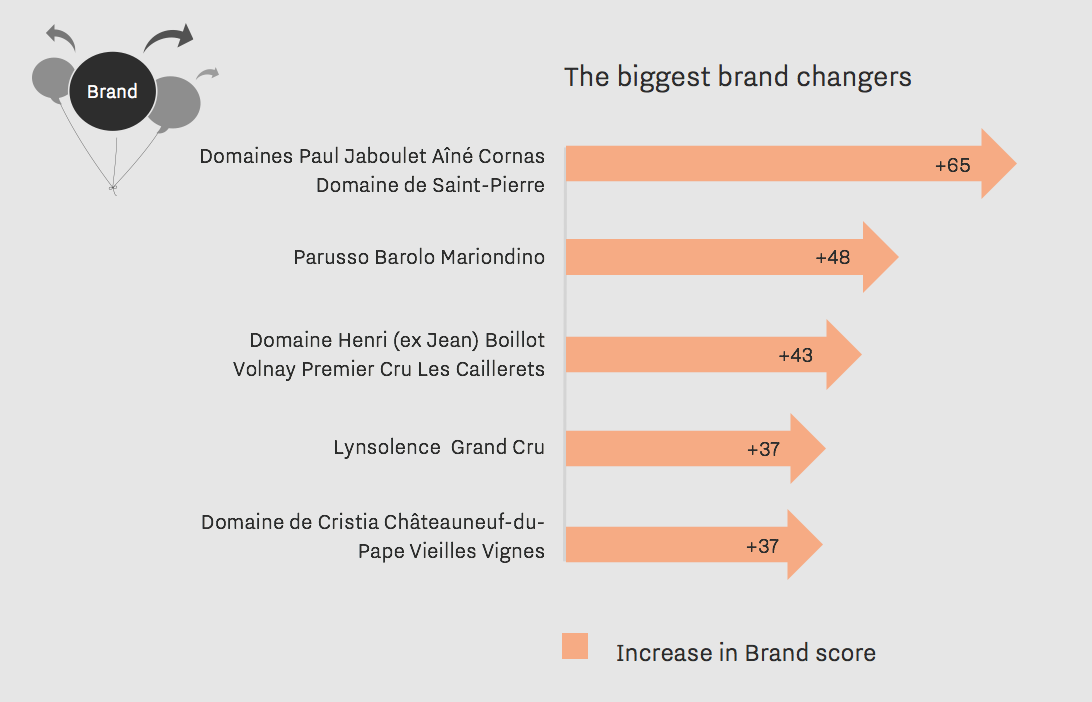
The brands on the rise in November were spread between several regions, with only the Rhône boasting two in the top five. Gaining most in terms of online searches month on month was Domaines Paul Jaboulet Aîné Cornas Domaine de Saint-Pierre. This saw a recent surge in average monthly searches, from 278 average monthly searches in the three-month period up to the end of October, to 639 now. This resulted in its brand score increasing by 65 points, up to 584 /1000.
Parusso Barolo Mariondino searches also increased substantially in the same period, from 140 to 270, taking its brand score to 434 – still below the average brand strength for wines on Wine Lister.
The Wine Lister Brand score algorithm has two components: Distribution and Popularity. The former criterion measures a wine’s presence in the world’s top restaurant wine lists. The latter measures the number of searches for each wine on the world’s most visited wine website Wine-Searcher, our Popularity Partner. We look at the number of times the wine is searched for over a rolling three-month period, and compare this to search frequencies of all other wines. The higher the relative search frequency, the higher the Popularity score.
Our latest score update includes updated Wine-Searcher data for October. The chart below shows the impact of new search data on Brand scores, showing the five biggest gainers:
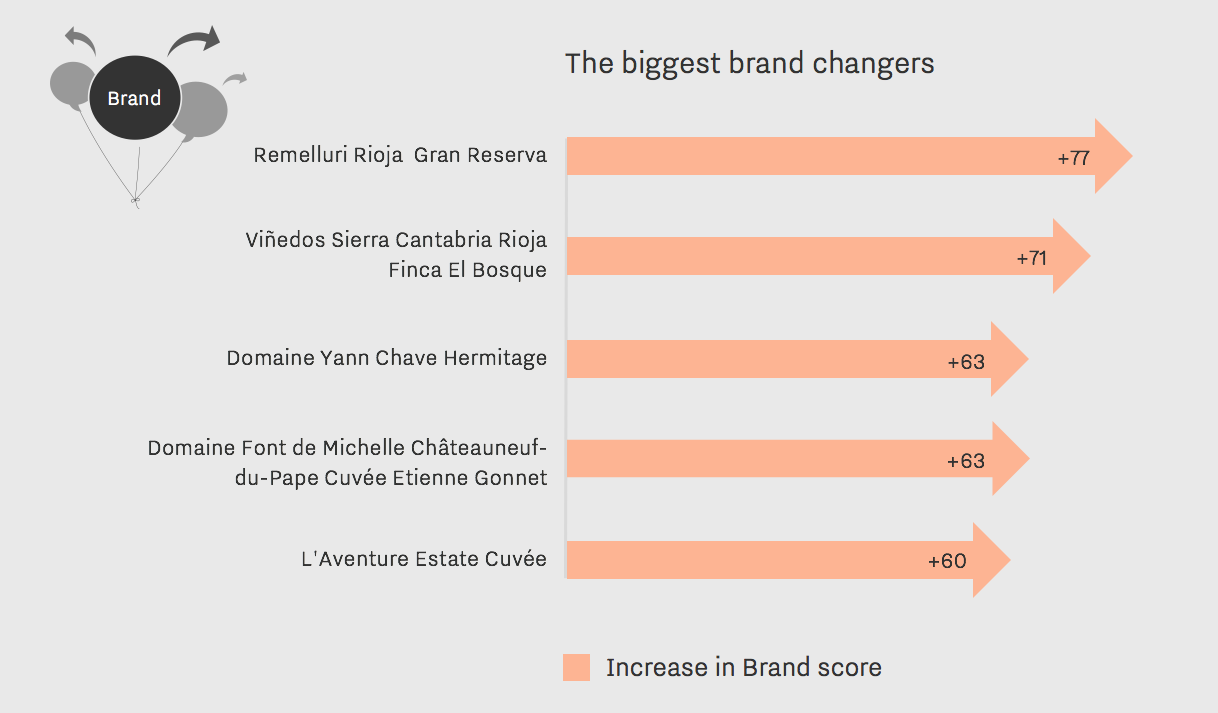
Rioja and the Rhône come out top. The largest gain in Brand score is for Remelluri Rioja Gran Reserva which has seen a considerable surge in user searches (322 monthly searches compared to 172 before the update), as has fellow Rioja, Viñedos Sierra Cantabria Finca El Bosque. In third and fourth place are two wines from the Rhône Valley: Domaine Yann Chave Hermitage and Domaine Font de Michelle Châteauneuf-du-Pape Cuvée Etienne Gonnet. The fifth biggest gainer in Brand terms is Californian adventurer, L’Aventure Estate Cuvée.
The graph below shows the average long term price performance of top scoring Wine Lister wines by country, and the USA bucks the trend of elites on top (with an early congratulatory nod from France).
We have split out performance for an elite group of the 15 highest-scoring wines, and compared this to performance for a wider panel of 50 wines. For the majority of countries, the elite wines – let’s call them the establishment – have seen their stock rise over the last three years.
In the USA, it is the broader-based group (the red column) that has trumped the establishment (gaining more than 9%). The same is true in France, where a broader group of wines has penned a tale of higher returns.
Our measure of long term price performance is the 3 year compound annual growth rate (CAGR) which facilitates comparison to other investment products.
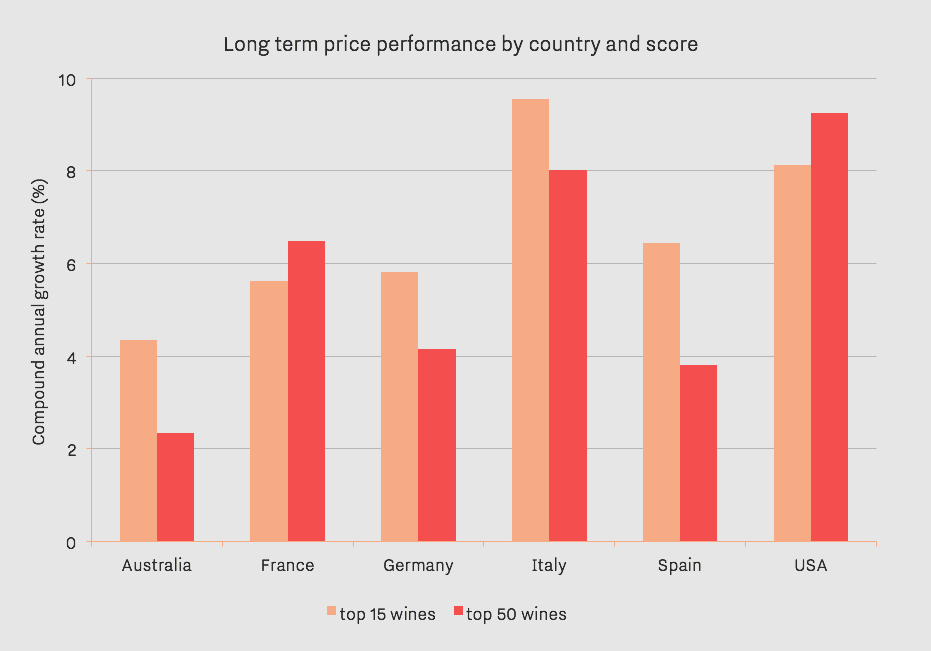
Elsewhere, Italian wines have seen the best returns among their elite group, averaging annual price gains of almost 10% – the most impressive of any group analysed here. One of the top performing wines in Italy’s top 15 scorers is Bartolo Mascarello’s Barolo (of “no barrique, no Berlusconi” fame), whose average (cross-vintage) price performance is 23% CAGR over the last 3 years.
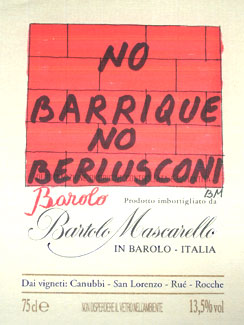
The elites also outperform the up-and-comers in Spain, Germany, and Australia, perhaps explained by the fact that there are fewer really well established top-end brands in these countries compared to France, and so their respective top 50 groups are less entrenched, and their top 15 groups still have room to grow in recognition and price.
This week saw the launch of Louis Roederer Cristal 2009. Addressing the London audience at the Shard on Tuesday 11th October, the Champagne house’s CEO, Frédéric Rouzaud, called the launch an effort “to help lift you out of depression after Brexit”.
The wine had been released in July, before the critics had tasted the wine, offered at £1,100 per case (91.67 per bottle) by UK merchants. It is still available at this price from BI Wines & Spirits, which seems like a good deal, the cheapest of any available (see the chart below).
Scores are now in from Wine Lister’s three partner critics (Vinous, Jancis Robinson, and Bettane+Desseauve) who are unanimous in their praise of the wine. See their scores alongisde a wealth of other data and analysis below:
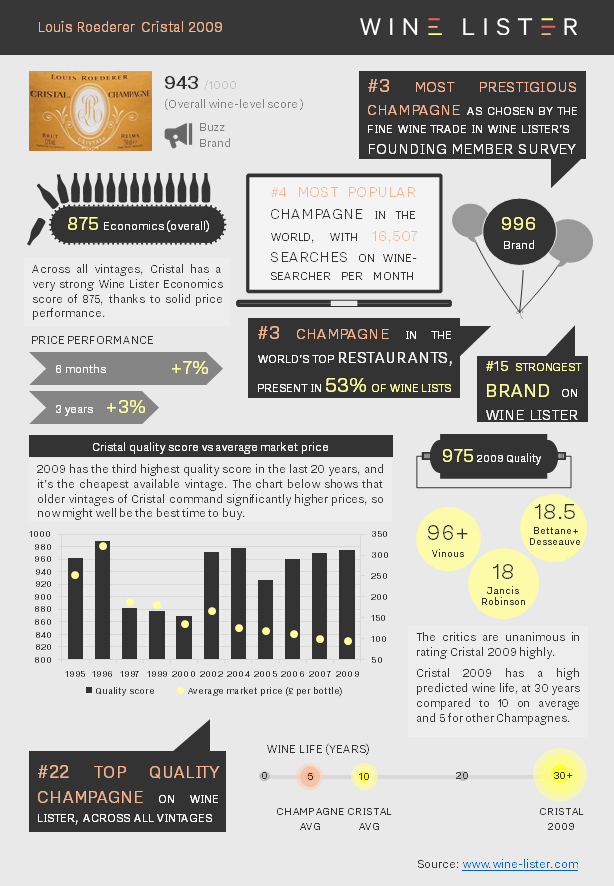
You can download the slide here: wine-lister-factsheet-cristal-2009











